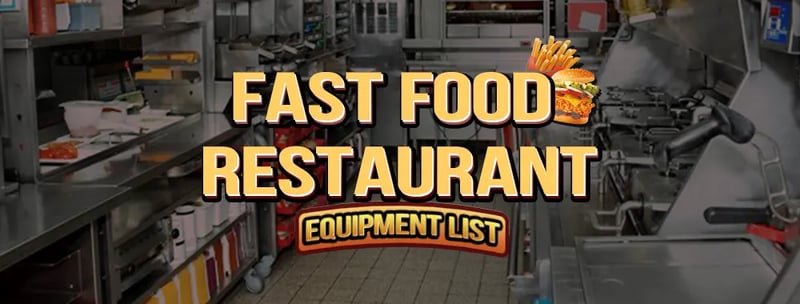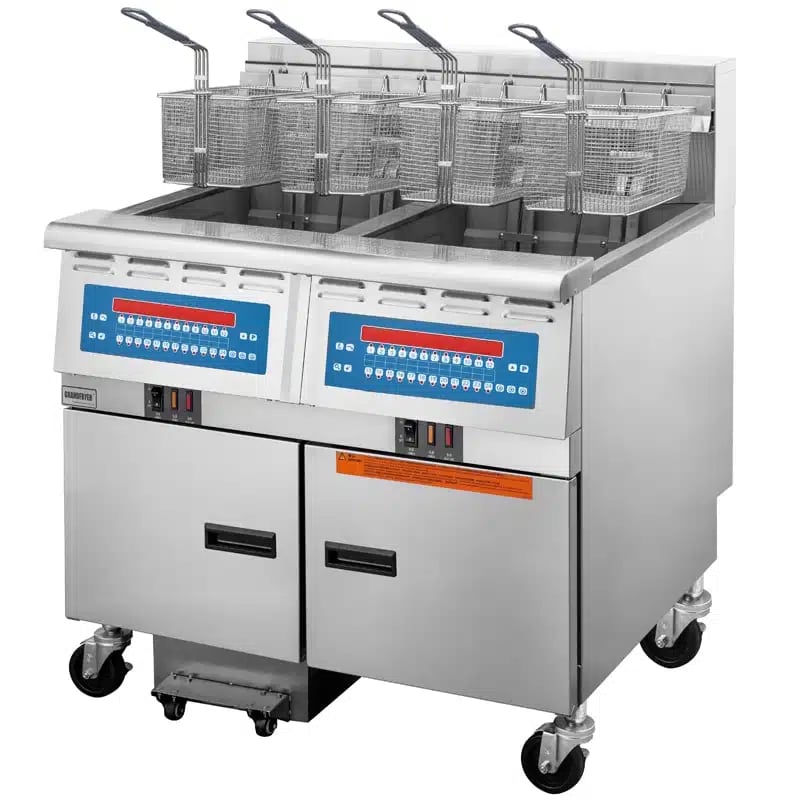
Catalogs
Latest Release
One-Stop Kitchen Equipment List for Fast Food Restaurant
Are you interested in starting a fast-food restaurant? Chefmax shares a checklist with complete fast-food restaurant equipment description and selection tips, including refrigeration equipment, food preparation equipment, cooking equipment, and other stainless steel equipment. If you are planning to open a fast-food restaurant, don't miss this guide.
Table of Contents
What are the advantages of starting a fast-food business?
Before everything starts, you need to know some basics and advantages of the fast food business, which can help you build a complete picture of fast food restaurants and the fast food industry in your mind.
Low Cost, High Profit
The pricing in the fast-food industry is generally not high, but the lower costs of ingredients and labor contribute to higher profit margins, around 6% to 9%.
Fast-food menus typically streamline operations, requiring employees to follow established procedures, and minimizing the need for extensive staff training or skilled chefs.
Profitability in fast food also depends on the restaurant's size and table turnover rate. Customers often opt for quick dining or takeout, requiring minimal seating and space, reducing significant rental costs.

Expanding Market Size
Despite the global impact of the COVID-19 pandemic, the global fast-food market continues to exhibit sustained growth. That is driven by the increasing demand for convenient foods, snacks, and ready-to-eat options.
As people increasingly prioritize balanced and healthy diets, the fast-food industry adapts to healthier eating habits, such as incorporating low-calorie options. That allows fast food to align with new and evolving industry trends.
Easily Replicable Model
The success of the fast-food model lies in its ease of replication, driven by standardization and simplification. Highly standardized cooking and service processes lead to reduced training costs. Simplicity means fast-food establishments focus on a few key products, lowering the complexity of ingredient procurement, inventory management, and food preparation.
Comprehensive fast-food restaurant equipment list
After understanding the advantages of choosing a fast food restaurant, have you started building your fast food restaurant blueprint in your mind? Chefmax will share a list of fast-food restaurant equipment and some selection tips to make it easy for you to include them in your considerations and shopping list.
1. Commercial Fryer
The deep fryer is the cornerstone of your fast-food kitchen, responsible for preparing over half of your menu items such as popular choices like fried chicken nuggets, chicken cutlets, fries, and nachos. Available in countertop and floor types, with the latter offering greater capacity.
Do I need to consider an oil filtration truck?
While other restaurant types may manually filter oil at day's end, franchised fast-food establishments often feature kitchens with dedicated frying areas, equipped with one or more fryers. To enhance kitchen efficiency and reduce operating costs, owners frequently opt for oil filtration carts to streamline the oil-filtering process.
Can a regular fryer support a whole chicken?
If you need to serve a whole chicken to your customers, we suggest the kitchen using a pressure fryer. Frying a whole chicken in a regular fryer within a short timeframe is challenging and may lead to uneven cooking, with the outside burning while the inside remains raw.
2. Ovens
Commercial ovens utilize sealed heating to bake or dry various food or product items. In fast-food settings, these ovens prove versatile, contributing to the preparation of pizza, desserts, wings, grilled meats, sandwiches, roasted vegetables, and more. Electric ovens typically offer an adjustable temperature range of 50-250°C, catering to the diverse needs of baked goods.
What kind of oven should I choose?
With options like Baking Ovens, Pizza Ovens, Combination Ovens, and Deck Ovens, the choices can be overwhelming. Chefmax recommends employing a specialized pizza oven for pizza preparation, while for a broader range of foods, a combination oven is ideal. Combination ovens offer steam, bake, and steam roast modes, providing fast-food establishments with a multifunctional solution that maximizes space efficiency.
3. Grill & Griddle
The commercial grill is equipped with a top metal plate that absorbs heat from the burner, facilitating the frying of food and melting of cheese. Foods like burger patties, steaks, sausages, eggs, and pancakes are typically prepared on a grill in fast-food restaurants.
Flat top grill or griddle?
While an open-fire grill offers more flavorful results and distinctive charred streaks on steaks, a flat-top grill is more suitable for the diverse tasks involved in frying burger patties within a fast-food setting. It provides a broader range of applications, allowing for the frying of eggs and vegetables. Some flat-top grills even feature a part of the surface with bumpy stripes, offering a convenient option for coloring steaks without a separate grill if they are only a small part of the menu.
4. Refrigerators & Freezers
Refrigerators are food storage and refrigeration equipment that every commercial kitchen has. They keep all types of vegetables, fruits, and meats fresh, extend their shelf life, and provide hygienic food safety in commercial kitchens. In a fast food restaurant, you may need them to refrigerate vegetables for salads, frozen fried chicken, chicken nuggets, and French fries.
Should I choose a solid door or a glass door?
Glass doors offer enhanced visibility, aiding employees in more efficiently accessing items. Typically, glass doors are suitable for refrigeration equipment but not for freezing equipment operating below 0 degrees. This is because glass doors are prone to fogging in significant temperature differentials, reducing visibility.
Does the location of the compressor unit have any influence?
For fast-food restaurants, we recommend a refrigerator with an under-mounted compressor.
The air at the bottom is usually cooler. With more fryers, the hot air is concentrated at the top and affects the heat dissipation of the refrigerator with the compressor unit at the top. With less dust and flour in the bottom air of a fast food kitchen than in a bakery, there is less chance of the refrigeration system getting clogged.
5. Ice machine
An ice machine is a refrigeration device that produces a large quantity of various types of ice in a short time. The fast-food kitchen primarily uses it to chill beverages such as iced tea, cola, and orange juice.
Should I choose water-cooled or air-cooled?
Chefmax recommends restaurants with fixed locations to use water-cooled ice makers. Water-cooled ice machines have a lower failure rate and provide more enduring ice-making effects. Air-cooled ice makers are mainly suitable for restaurant types that operate outdoors.
Under-counter, modular, or self-contained ?
These types of ice makers vary in capacity. Undercounter ice makers have the smallest capacity, while modular ice makers have a larger capacity with a separate ice storage bin, depending on the scale of the fast-food restaurant. When choosing the specifications based on production capacity, it's essential to consider the demand for ice during peak hours rather than the daily output.
6. Pizza, Sandwich, and Salad Workstations
Fast-food establishments often offer pizza, sandwiches, and salads. The workstation dedicated to storing and assembling these foods comprises a storage cabinet, a worktable, and multiple food trays. You can place different ingredients in the trays and assemble pizzas or sandwiches on the work table.
The distinction between the pizza workstation and the sandwich and salad workstation lies in the size of its worktable, allowing operators to accommodate pizzas.
Should I choose air-cooled or direct cooling?
For the sandwich and salad workstation, we recommend air-cooled models. In the case of direct cooling models, the uneven cooling they provide can potentially freeze high-moisture ingredients, especially delicate leafy greens. Air-cooled models, on the other hand, ensure uniform cooling. However, do not expose vegetables directly to storage cabinets as circulating air may cause leafy vegetables to lose moisture.
Both refrigeration methods are suitable for pizza workstations, as pizza ingredients mainly consist of carrots, onions, meat, cheese, dough, etc., with minimal use of leafy greens.
7. Food processor
Food processors are versatile machines capable of handling diverse tasks, from mixing cake batter to mincing meat. They excel in functions like mixing, chopping, grinding, slicing, and creating purees. Widely employed in fast-food establishments, these processors efficiently handle vegetable chopping and sauce preparation, incorporating ingredients like carrots, cabbage, and cucumbers.
Batch bowls or combination processors?
When deciding between batch bowls and combination processors, fast-food restaurants benefit more from the latter due to space efficiency and enhanced functionality. Combination processors offer a broader range of applications and increased throughput. While batch bowls are suitable for liquids like sauce mixing, with smaller capacities, combination processors shine in processing solid foods. They can seamlessly switch between various blades for tasks such as shredding, chopping, and slicing, making them ideal for fast-food establishments producing salads, chips, pizza ingredients, and more.
8. Meat cutters
Commercial meat cutters are indispensable for precision cutting various meats and cheeses commonly used in fast-food establishments, including cheese slices, meat rolls, chops, ham slices, and more. This equipment offers adjustable slicing thickness ranging from the thinnest to approximately 15 mm.
How does the type of meat affect the choice of meat cutter?
When selecting a meat cutter, the type of meat plays a crucial role. Choose from frozen meat cutters, fresh meat cutters, and deli-type cutters. It's essential to avoid mixing them, as using a fresh meat cutter for frozen meat can damage blades and motors. Deli cutters should exclusively handle cooked food, and separation from raw meat cutters is vital to prevent bacterial growth and cross-contamination.
9. Mixers
For those requiring the production of artisan bread, sandwiches, pizza, and burger dough in a kitchen setting, acquiring a commercial mixer stand as a prudent investment. This versatile equipment excels in batch processing, ensuring even and swift mixing to enhance overall preparation efficiency.
10. Stainless Steel Worktops
Stainless steel worktops serve as sturdy surfaces for tools and various preparations, featuring dividers or cabinets for ingredient and tool storage. The worktops are designed with shelves to optimize kitchen space by allowing for hanging or placing additional items.
Does the material of the table matter?
The material directly impacts the table's lifespan, with materials prone to rust or staining posing health and safety risks. Stainless steel worktops are available in 430 and 304 grades. While 430 is more affordable, it may be susceptible to rust. On the other hand, 304, though pricier, offers superior quality, ease of cleaning, and greater rust resistance. In locations with high humidity or proximity to the sea, 304 is the recommended choice.
Can I customize stainless steel worktops?
Stainless steel worktops are highly customizable to fit your kitchen layout. They can be tailored for specifications, including cabinets and tables, backsplashes, dividers, built-in sinks, single or double layers, casters, drawers, etc. This customization ensures maximum space utilization.

11. Hoods
Hoods are integral components of comprehensive kitchen equipment, prioritizing health and safety. In fast-food kitchens, where frying, pan-frying, and grilling are predominant cooking methods, hoods maintain a clean kitchen environment and minimize soot particles on equipment surfaces.
Type I or Type II?
For fast-food kitchens, Type I hoods are the preferred choice. The distinction lies in their design, with Type I hoods tailored for cooking equipment generating grease and smoke, such as deep fryers, frying pans, and grills. On the contrary, Type II hoods are suitable for non-grease-producing equipment like ovens and steamers, effectively managing heat, steam, and odors to uphold optimal kitchen conditions.

Summary
Embarking on a fast-food venture demands thorough contemplation and meticulous planning. Leveraging two decades of manufacturing and sales expertise, Chefmax stands as a stalwart supporter of all aspects of establishing a one-stop fast-food restaurant kitchen. For further insights into one-stop fast-food restaurant equipment, please don't hesitate to reach Chefmax.









